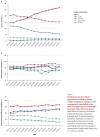Defining hospitalist physicians using clinical practice data: a systems-level pilot study of Ontario physicians
- PMID: 25237402
- PMCID: PMC4161497
Defining hospitalist physicians using clinical practice data: a systems-level pilot study of Ontario physicians
Abstract
Background: Hospitalists have become dominant providers of inpatient care in many North American hospitals. Despite the global growth of hospital medicine, no objective method has been proposed for defining the hospitalist discipline and delineating among inpatient practices on the basis of physicians' clinical volumes. We propose a functional method of identifying hospital-based physicians using aggregated measures of inpatient volume and apply this method to a retrospective, population-based cohort to describe the growth of the hospitalist movement, as well as the prevalence and practice characteristics of hospital-based generalists in one Canadian province.
Methods: We used human resource databases and financial insurance claims to identify all active fee-for-service physicians working in Ontario, Canada, between fiscal year 1996/1997 and fiscal year 2010/2011. We constructed 3 measures of inpatient volume from the insurance claims to reflect the time that physicians spent delivering inpatient care in each fiscal year. We then examined how inpatient volumes have changed for Ontario physicians over time and described the prevalence of full-time and part-time hospital-based generalists working in acute care hospitals in fiscal year 2010/2011.
Results: Our analyses showed a significant increase since fiscal year 2000/2001 in the number of high-volume hospital-based family physicians practising in Ontario (p < 0.001) and associated decreases in the numbers of high-volume internists and specialists (p = 0.03), where high volume was defined as ≥ 2000 inpatient services/ year. We estimated that 620 full-time and 520 part-time hospital-based physicians were working in Ontario hospitals in 2010/2011, accounting for 4.5% of the active physician workforce (n = 25 434). Hospital-based generalists, consisting of 207 family physicians and 130 general internists, were prevalent in all geographic regions and hospital types and collectively delivered 10% of all inpatient evaluation and care coordination for Ontario residents who had been admitted to hospital.
Interpretation: These analyses confirmed a substantial increase in the prevalence of general hospitalists in Ontario from 1996 to 2011. Systems-level analyses of clinical practice data represent a practical and valid method for defining and identifying hospital-based physicians.
Conflict of interest statement
None declared.
Figures


Similar articles
-
Hospitalists and the practice of inpatient medicine: results of a survey of the National Association of Inpatient Physicians.Ann Intern Med. 1999 Feb 16;130(4 Pt 2):343-9. doi: 10.7326/0003-4819-130-4-199902161-00003. Ann Intern Med. 1999. PMID: 10068403
-
Variation in Physician Spending and Association With Patient Outcomes.JAMA Intern Med. 2017 May 1;177(5):675-682. doi: 10.1001/jamainternmed.2017.0059. JAMA Intern Med. 2017. PMID: 28288254 Free PMC article.
-
A majority of family physicians use a hospitalist service when their patients require inpatient care.J Prim Care Community Health. 2015 Apr;6(2):70-6. doi: 10.1177/2150131914555016. Epub 2014 Oct 15. J Prim Care Community Health. 2015. PMID: 25318473
-
Knowledge, patterns of care, and outcomes of care for generalists and specialists.J Gen Intern Med. 1999 Aug;14(8):499-511. doi: 10.1046/j.1525-1497.1999.08168.x. J Gen Intern Med. 1999. PMID: 10491236 Free PMC article. Review.
-
Hospitalists as Facilitators of Surge and Contingency Medical Operations and Planning.Mil Med. 2024 Feb 27;189(3-4):70-73. doi: 10.1093/milmed/usad320. Mil Med. 2024. PMID: 37606620 Review.
Cited by
-
Hospitalists reduce harm and improve care for hospitalized patients.Can Fam Physician. 2017 Jul;63(7):510-511. Can Fam Physician. 2017. PMID: 28701436 Free PMC article. No abstract available.
-
Family physician perspectives on primary care reform priorities: a cross-sectional survey.CMAJ Open. 2021 May 6;9(2):E466-E473. doi: 10.9778/cmajo.20200102. Print 2021 Apr-Jun. CMAJ Open. 2021. PMID: 33958382 Free PMC article.
-
Determinants of Hospital-based Physician Participation in Quality Improvement: A Survey of Hospitalists in British Columbia, Canada.Glob J Qual Saf Healthc. 2020 Feb 6;3(1):6-13. doi: 10.4103/JQSH.JQSH_17_19. eCollection 2020 Feb. Glob J Qual Saf Healthc. 2020. PMID: 37440968 Free PMC article.
-
Characteristics of the ideal hospitalist inpatient care program: perceptions of Canadian health system leaders.BMC Health Serv Res. 2021 Jul 4;21(1):648. doi: 10.1186/s12913-021-06700-0. BMC Health Serv Res. 2021. PMID: 34217270 Free PMC article.
-
Modern work patterns of "classic" versus millennial family doctors and their effect on workforce planning for community-based primary care: a cross-sectional survey.Hum Resour Health. 2020 Sep 21;18(1):67. doi: 10.1186/s12960-020-00508-5. Hum Resour Health. 2020. PMID: 32958028 Free PMC article.
References
-
- Yousefi V, Wilton D. Re-designing hospital care: learning from the experience of hospital medicine in Canada. J Glob Health Care Syst. 2011;1(3):1–10. Available from: http://jghcs.info/index.php/j/article/view/47/57.
-
- Soong C, Fan E, Howell EE, Maloney RJ, Pronovost PJ, Wilton D, et al. Characteristics of hospitalists and hospitalist programs in the United States and Canada. J Clin Outcomes Manag. 2009;16(2):69–74.
-
- Wachter RM. The state of hospital medicine in 2008. Med Clin North Am. 2008;92(2):265–273. - PubMed
-
- Wachter RM, Bell D. Renaissance of hospital generalists. BMJ. 2012;344:e652–e652. - PubMed
Publication types
MeSH terms
Grants and funding
LinkOut - more resources
Full Text Sources
